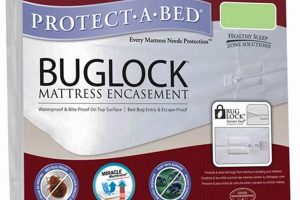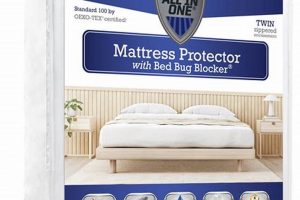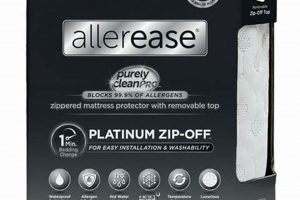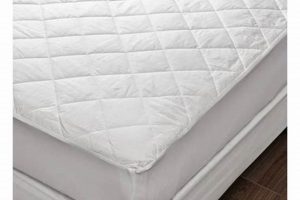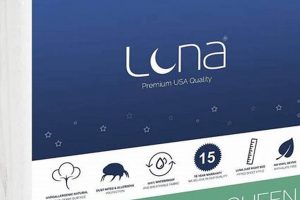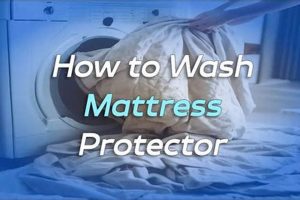An impermeable covering designed to shield a small child’s sleeping surface from liquids and other potential contaminants. It typically encases the entire mattress or a significant portion thereof, creating a barrier against spills, accidents, and dust mites.
The implementation of such a barrier offers significant advantages in maintaining a hygienic sleeping environment for young children. These protective solutions contribute to extended mattress lifespan by preventing internal damage from moisture and stains. Historically, similar materials were employed for furniture protection; current applications leverage advances in manufacturing to create safer and more comfortable options for infants and toddlers.
The following discussion will elaborate on the various types of these protective layers, their specific features, selection criteria, proper maintenance, and potential safety considerations.
Practical Guidance for Selecting a Protective Layer
The following guidance serves to inform the selection and implementation of a protective layer for a toddler’s bed, ensuring both hygiene and the longevity of the sleeping surface.
Tip 1: Prioritize Material Safety. Verify that the composition is free of phthalates, lead, and PVC. Certifications such as OEKO-TEX Standard 100 indicate testing for harmful substances.
Tip 2: Assess Waterproofing Effectiveness. Evaluate the degree of impermeability to liquids. Look for descriptions like “waterproof” or “water-resistant,” understanding that “waterproof” offers greater protection.
Tip 3: Consider Breathability. A breathable material minimizes heat retention and enhances comfort. Options with a thin, breathable membrane layered beneath the plastic surface are preferable.
Tip 4: Evaluate Fit and Attachment. The protector should fit snugly to prevent shifting and bunching. Fitted sheet styles with elasticized edges or zippered encasements offer secure attachment.
Tip 5: Examine Durability and Washability. Opt for a construction that withstands repeated laundering and resists tearing. Reinforcements at seams and corners enhance longevity.
Tip 6: Mind the Noise Factor. Some options can produce crinkling sounds. Read reviews or test the material to minimize disruption during sleep.
Tip 7: Adhere to Manufacturer Instructions. Follow all cleaning and maintenance guidelines to ensure the protector functions effectively and remains hygienic.
By heeding these guidelines, parents and caregivers can make informed choices, securing a product that safeguards the mattress and promotes a healthier sleep environment for the child.
This concludes the section on practical guidance. The article will now proceed to discuss potential safety considerations surrounding the use of these products.
1. Waterproof Barrier Integrity
Waterproof barrier integrity represents the core functional attribute of a protective layer intended for a toddler’s sleeping surface. It describes the capacity of the material to completely prevent the permeation of liquids, safeguarding the underlying mattress from spills, bodily fluids, and other forms of moisture. Compromised integrity renders the protective layer ineffective, leading to potential mattress damage, bacterial growth, and allergen accumulation. For example, a visible tear or pinhole in the plastic layer would immediately negate its waterproof capability, allowing fluids to penetrate and saturate the mattress core.
The importance of this barrier extends beyond mere protection; it directly impacts hygiene and sanitation. A mattress exposed to repeated liquid intrusion becomes a breeding ground for mold, mildew, and bacteria, posing health risks to the toddler. A protective layer with demonstrable integrity simplifies cleaning and disinfection, allowing for quick and effective removal of contaminants. Regular inspection of the protective layer for signs of wear, tear, or degradation is crucial for maintaining its intended function. Furthermore, the selection of a product constructed from high-quality, durable materials directly influences the long-term viability of the waterproof barrier.
In summary, waterproof barrier integrity is an indispensable characteristic of a protector for a toddler’s bed. Its effectiveness dictates the level of protection afforded to the mattress, the hygiene maintained within the sleep environment, and, consequently, the overall health and well-being of the child. Neglecting this aspect compromises the very purpose of employing a protective covering.
2. Material Safety Certification
Material Safety Certification, in the context of protective layers designed for toddler beds, serves as a critical indicator of product safety and adherence to established regulatory standards. It assures consumers that the item has undergone rigorous testing to minimize potential exposure to harmful chemicals and substances.
- Absence of Phthalates and PVC
Many certifications specifically verify the absence of phthalates, plasticizing agents linked to adverse health effects, and PVC (polyvinyl chloride), a polymer that can release harmful dioxins during production or incineration. For instance, products bearing a “Phthalate-Free” label or a certification against PVC content assure parents of reduced chemical exposure for their child.
- Compliance with Lead Content Regulations
Certifications often mandate strict adherence to lead content limits, crucial because lead exposure, even at low levels, can impair neurological development in young children. A product displaying the CPSIA (Consumer Product Safety Improvement Act) compliance symbol signifies that it meets stringent lead restrictions set by the U.S. government.
- OEKO-TEX Standard 100
The OEKO-TEX Standard 100 is a widely recognized certification system that tests textiles for a broad range of harmful substances, including formaldehyde, pesticides, and heavy metals. A protector carrying this certification signifies that every component of the product, from the plastic layer to the binding materials, has been tested and deemed safe for direct contact with sensitive skin.
- GREENGUARD Certification
GREENGUARD certification focuses on indoor air quality, ensuring that the protector emits minimal volatile organic compounds (VOCs). These VOCs can contribute to respiratory irritation and other health issues. A GREENGUARD certified protector has been tested and verified to meet strict VOC emission standards, promoting a healthier sleep environment.
In summation, securing a protective layer that possesses relevant Material Safety Certifications provides assurance that the product meets specific safety criteria and reduces the risk of exposing the child to harmful chemicals and substances. The presence of these certifications allows for a more informed purchasing decision, prioritizing the health and well-being of the child using the product.
3. Proper Size and Fit
The correct dimensions and secure positioning are critical elements in the functionality of a protective layer designed for a toddler’s bed. Incompatibility in size compromises the protector’s ability to shield the mattress from liquids and allergens, rendering it largely ineffective. A protector that is too small will leave portions of the mattress exposed, while one that is excessively large will bunch and shift, creating discomfort and potential safety hazards.
The correct size and tight fit contributes to the overall hygiene and lifespan of the mattress. A properly fitted protector forms a complete, impermeable barrier against spills and accidents. Consider, for example, a scenario where a toddler experiences a nighttime accident. If the protector is the correct size and securely fitted, the liquid is contained on the surface and easily cleaned, preventing absorption into the mattress. Conversely, a loose-fitting or undersized protector would allow the fluid to seep into the mattress, leading to potential staining, odor, and microbial growth, thus shortening the mattress’s lifespan. Ensuring accurate sizing and secure attachment mechanisms, such as elasticized edges or zippered enclosures, is paramount for optimal protection.
Therefore, the selection of a protective layer must prioritize accurate measurements of the toddler bed mattress and adherence to the manufacturer’s sizing specifications. Neglecting the importance of precise dimensions and a secure fit negates the intended protective benefits, compromising hygiene and potentially impacting the child’s comfort and safety.
4. Breathability Considerations
The permeability of a protective layer for a toddler’s bed directly influences the sleep environment. Materials lacking sufficient airflow can trap heat and moisture, creating discomfort and potentially disrupting sleep patterns. A careful evaluation of breathability is thus essential when selecting such a product.
- Moisture Accumulation and Microbial Growth
Insufficient breathability impedes the evaporation of perspiration and other fluids, fostering an environment conducive to microbial growth. This can lead to unpleasant odors and potentially trigger allergic reactions or skin irritations in susceptible individuals. For example, prolonged contact with a damp surface encourages the proliferation of mold and bacteria, necessitating more frequent and intensive cleaning of the protector and the mattress itself.
- Heat Retention and Thermal Discomfort
A non-breathable protector traps body heat, leading to elevated skin temperature and discomfort, particularly during warmer months. This thermal discomfort disrupts sleep and can cause restlessness. Consider a scenario where a toddler, already prone to night sweats, sleeps on a mattress covered with a non-breathable layer. The trapped heat can exacerbate sweating, leading to discomfort and disturbed sleep.
- Material Composition and Air Permeability
The choice of materials directly impacts air permeability. While the primary function of a protector necessitates a waterproof barrier, incorporating breathable materials within the construction mitigates the negative effects of impermeability. For instance, a protector comprised of a thin, waterproof membrane laminated to a breathable fabric allows moisture vapor to escape while preventing liquid penetration. This combination provides a balance between protection and comfort.
- Construction Methods and Ventilation Features
Design elements such as micro-perforations or specialized weave patterns can enhance airflow without compromising waterproof integrity. These features facilitate the escape of moisture vapor, reducing humidity levels within the sleep environment. For instance, some protectors incorporate a three-dimensional spacer fabric that creates air channels, promoting ventilation and minimizing moisture accumulation.
The integration of breathable materials and ventilation features into protective layers for toddler beds represents a crucial consideration in ensuring a comfortable and hygienic sleep environment. Failing to address breathability concerns can lead to moisture accumulation, thermal discomfort, and an increased risk of microbial growth, ultimately impacting the quality of sleep and the overall health of the child.
5. Maintenance Procedures
Adherence to prescribed care guidelines is crucial for preserving the protective capabilities and extending the lifespan of a plastic mattress protector designed for a toddler’s bed. Inadequate or inappropriate cleaning practices compromise the integrity of the material, fostering the growth of microorganisms and diminishing the barrier function against liquids and allergens.
- Regular Cleaning Schedule
Establishing a consistent cleaning regimen prevents the accumulation of spills, bodily fluids, and dust mites. The frequency of cleaning depends on usage and potential incidents; however, a monthly cleaning is generally recommended. For example, a spill should be addressed immediately to prevent staining and bacterial growth. A protector exposed to regular nighttime accidents may require more frequent attention. Regular cleaning prevents the buildup of allergens and maintains a hygienic sleeping surface for the child.
- Appropriate Cleaning Agents
The selection of cleaning agents directly impacts the material integrity of the protector. Harsh chemicals or abrasive cleaners can degrade the plastic, leading to cracks, tears, or loss of waterproof properties. Mild detergents, diluted with water, are typically recommended. For instance, a solution of mild dish soap and water effectively removes most stains and spills without damaging the plastic. Avoiding bleach or solvents is crucial for maintaining the protector’s integrity. Using the appropriate cleaning agent ensures the long-term viability and effectiveness of the protective barrier.
- Proper Drying Techniques
Drying methods must prevent heat damage and ensure complete moisture removal. High heat from a dryer can melt or warp the plastic, rendering it ineffective. Air drying or tumble drying on a low heat setting is preferable. For example, hanging the protector outdoors on a clothesline allows for natural air circulation and evaporation. Incomplete drying fosters the growth of mold and mildew. Adhering to proper drying techniques prolongs the protector’s lifespan and prevents the development of unhealthy conditions.
- Inspection and Replacement
Routine inspection for wear and tear is essential for maintaining optimal protection. Check for cracks, tears, or areas where the plastic has thinned. A compromised protector no longer provides an effective barrier against liquids and allergens. For example, a visible crack indicates a breach in the waterproof layer, necessitating replacement. Regular inspection, coupled with timely replacement, ensures continuous protection for the toddler’s mattress and preserves a hygienic sleeping environment.
Consistent adherence to these maintenance procedures is paramount for safeguarding the functionality of the protector. Failure to observe these guidelines diminishes the protective benefits, potentially exposing the toddler to harmful substances and compromising the lifespan of the mattress. Prioritizing regular cleaning, employing suitable cleaning agents, practicing proper drying techniques, and conducting routine inspections ensures that the plastic mattress protector effectively serves its intended purpose: providing a safe and sanitary sleeping environment for the child.
Frequently Asked Questions
The following section addresses common inquiries regarding protective coverings for toddler beds, providing clarity on usage, safety, and maintenance.
Question 1: What constitutes a suitable material for a plastic mattress protector intended for a toddler bed?
Ideal materials should be waterproof, durable, and free from harmful chemicals such as phthalates and PVC. Polyurethane is frequently used due to its water resistance and flexibility. The material should possess certifications confirming its safety for use with children.
Question 2: How often should a plastic mattress protector be cleaned?
Routine cleaning is recommended on a monthly basis, or more frequently if spills or accidents occur. Spills must be addressed immediately to prevent staining and microbial growth. Adherence to the manufacturer’s cleaning instructions is essential to preserve material integrity.
Question 3: What are the potential safety concerns associated with these products?
Primary concerns include the presence of harmful chemicals, inadequate breathability leading to overheating, and potential suffocation hazards if the protector is not properly fitted. Selecting certified products and ensuring a snug fit mitigates these risks.
Question 4: How does one ensure a proper fit?
Accurate measurement of the mattress dimensions is crucial. The protector should correspond precisely to these measurements. Fitted sheet styles with elasticized edges or zippered encasements offer a secure and snug fit.
Question 5: What measures can be taken to enhance breathability?
Selecting options incorporating breathable membranes or micro-perforations promotes airflow and reduces moisture buildup. Avoid thick, non-breathable plastics that trap heat. Look for protectors that combine a waterproof layer with a breathable fabric.
Question 6: How does one dispose of a used plastic mattress protector responsibly?
Given that most plastic protectors are not biodegradable, recycling may not always be an option. Check local recycling guidelines for specific instructions. Consider repurposing the material for other protective applications if possible.
In summary, selecting a protector with certified materials, ensuring a correct fit, maintaining a regular cleaning schedule, prioritizing breathability, and adhering to responsible disposal methods are essential for safe and effective use.
This concludes the FAQ section. The subsequent segment will address key factors to consider before buying.
Conclusion
The preceding exploration of the utility, safety, and maintenance of a plastic mattress protector for toddler bed underscores the significant role this item plays in safeguarding a child’s sleeping environment. Selecting a model that balances impermeable protection with breathable comfort, confirmed through material safety certifications, remains paramount. Furthermore, proper sizing, cleaning, and ongoing inspection are integral to its continued effectiveness.
The investment in a high-quality, well-maintained protective layer represents a commitment to both the longevity of the mattress and the hygiene of the child’s sleep space. Careful consideration of the factors outlined herein will facilitate informed purchasing decisions, ultimately contributing to a healthier and more restful sleep experience.


